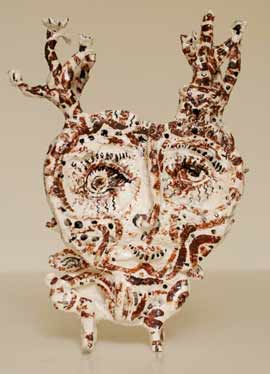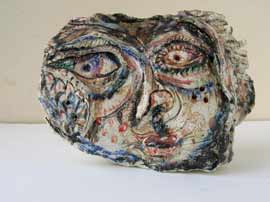Project 11 GOW
May 9th – 4th June 2011
Jasna Nikolic
At the margins of medieval art is a world of wonder in which the seen and unseen coexist in natural harmony. Clinging to the corbels, capitals, portals and misericords that occupy the edges of architectural space, and filling the borders of manuscripts and other objects; peasants and knights jostle for space with hybrid creatures and monstrous grotesques, bringing the presence of the un-encountered other into the realm of the everyday.
To our modern sceptical eyes griffins and green-men, mermaids and dragons are the stuff of fairy tale; fantastical creations that have no basis in reality. But to those who carved, painted and embroidered these creatures this was not a land of make-believe, but a depiction of the world of faith in which they lived, where the seen and unseen were equally real. These creatures were inhabitants of the periphery; beings whose presence is only half-glimpsed as a blurred sensation out of the corner of the eye. Their homes the unattainable edgelands - the woods, hills, and sea that lie just over the always distant horizon.
It is said that we open our eyes wide in wonder. But when we do so our depth of focussed field becomes narrower and our vision becomes more blurred and indeterminate; less solid and more mercurial as defined boundaries blur into flowing undefined spaces. It is this sense of liquid, uncertain space that we encounter in the work of the Serbian artist Jasna Nikolic. Her linear, fantastical creatures float in a sea of colour where foreground and background blur into an amorphous whole. From within clouds of subtle pastel tones, winged faces and hearts, sailing boats, and animals emerge as if from a dream; their clearly symbolic presence tantalising with the offer of some deeper meaning rather than a representational reality; serving as embodiments of prayer and enlightenment, or providing simple, fizzing bursts of pure vitality and joy expressed in line and colour.
The dancing, ecstatic character of Nikolic’s lines continues between her paintings and ceramic sculptures. For just as there was no division in the Middle Ages between art forms and artists, so these works reflect an holistic vision, one that sees the world as an interconnected space, where the boundaries that divide the sacred from secular, the natural from the man-made, art from craft, and the real from the unreal have been broken down. In these entwined spaces we encounter time differently as the normal boundaries created by linear space and time are dissolved. Time seems to stand still as we stand on the threshold between earth and heaven, each painting and sculpture a threshold in which symbols of the sacred mingle with the mundane matter of life. These are landscape paintings and sculptures; but they are imagined, prophetic landscapes depicting a new heaven and earth, rather than the visible world of tangible reality alone.
The innocent, child-like quality of these works perfectly captures the sense of rapturous joy that has inspired their creation. They conjure up a world of imprecise spaces and hybrid creatures; the peripheral, unfocussed world of the half-seen that inspires the question - ‘I wonder?’ And whilst this question will lead to the searching focus of investigation and the defined, categorizing boundaries of knowledge that can seem to seal the world’s porous thresholds, these works remind us of that threshold space on the edge where the seen and unseen, known and unknown mingle – the space of wonder.
Essay: Revd Dr Richard Davey
Co-ordinating Chaplain - Nottingham Trent University
www.jasnanikolic.com




